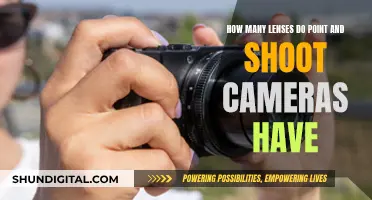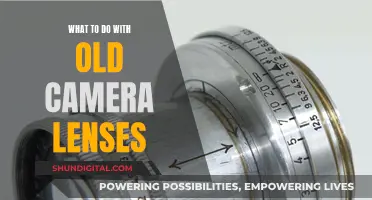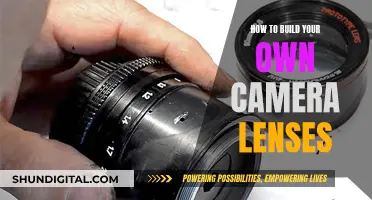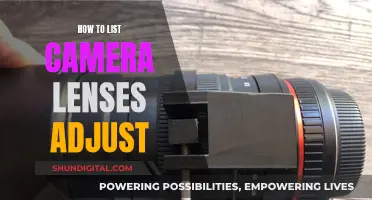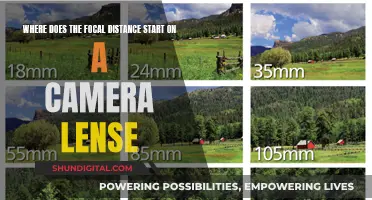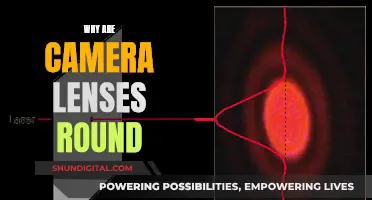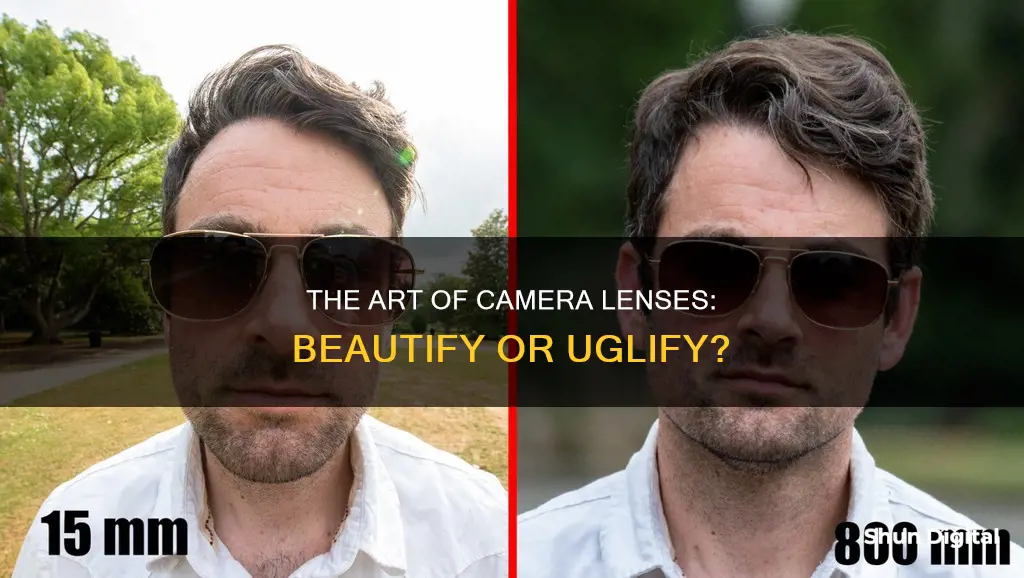
Ever wondered why you look better in some photos than in others, even when you're smiling and the lighting is good? It's all down to the camera lens. Camera lenses bend light rays and capture a two-dimensional picture within a limited field of view, and the resulting image will be more or less deformed depending on the lens' focal length. This deformation can make a face look prettier or uglier than it is in real life.
| Characteristics | Values |
|---|---|
| Lens distortion | The shorter the focal length, the more field of view is captured, and the more distortion occurs. |
| The distortion can make a face look prettier or uglier than it is in reality. | |
| The distortion is more obvious near the sides of the frame. | |
| Focal length | A shorter focal length can make the subject look thinner. |
| A longer focal length can make the subject's face look flatter and wider. | |
| A 135mm lens is said to produce the most accurate results, but this also depends on the subject's anatomy. |
What You'll Learn

The impact of lens distortion
Camera lenses can have a significant impact on the way we look in photographs, and this is due to lens distortion. Lenses do not work like our eyes; they bend light rays and capture a two-dimensional image within a limited field of view. This is where lens distortion occurs, and it can either beautify or uglify a person's face in a photo.
The degree of distortion depends on the lens' focal length. A shorter focal length will result in more distortion, with the image appearing more deformed. For example, using a 19mm lens will result in extreme distortion, making the subject's face look very different from how it appears in real life. As the focal length increases, the distortion becomes more subtle and less obvious. This subtler distortion can make a face look prettier or uglier than it actually is, and because it is not noticeable, our minds accept the image as accurate.
The anatomy of a person's face also plays a role in how they are affected by lens distortion. Some people are considered "photogenic" because their facial features suit most camera lenses and result in flattering images. On the other hand, certain lenses may emphasise undesirable features, making some people look worse in photos than they do in real life.
The distance between the subject and the camera also affects the distortion. When taking photos with a cellphone or compact camera, placing the subject in the centre of the frame can make them look better, especially from a distance. Moving the subject to the sides of the frame can alter their appearance due to the distortion being more obvious near the edges of the image.
Additionally, the type of lens used can affect the distortion. For example, a 50mm lens may result in different distortion compared to a 135mm lens, with the latter providing a warmer skin tone and a more flattering image. Understanding the impact of lens distortion can help photographers adjust their settings and choose the most suitable lens to capture the best images of their subjects.
Welding and Cameras: Can Welding Damage Camera Lenses?
You may want to see also

How focal length affects the image
The focal length of a camera lens determines what the camera can focus on and how images will turn out. It is the distance measured in millimetres between the optical centre of the lens and the camera sensor, where light information is recorded.
Lenses with shorter focal lengths have a wider angle of view and make subjects appear smaller, requiring the photographer to stand closer to fill the frame. These lenses are used in architectural, documentary, and landscape photography. Photos taken with shorter focal lengths will also experience distortion, particularly around the edges.
Lenses with longer focal lengths are often referred to as "telephoto lenses". They allow photographers to keep a distance from their subjects and are ideal for sports, wildlife, or wedding photography. Longer focal lengths also result in less distortion.
The focal length can also affect the perspective of an image, but this is influenced indirectly. Changing the focal length does not directly impact the relative dimensions and positions of objects within the frame. However, it does allow the photographer to move closer or farther from the subject, which in turn affects the perspective.
The best focal length for a photograph depends on the subject matter and situation. Photographers can adjust the focal length to capture their subjects in the best light, making them appear more or less attractive depending on the lens used.
APS-C Lenses: Universal Fit for All Cameras?
You may want to see also

The difference between 2D and 3D images
In photography, 2D images are created when camera lenses capture light and bend it into a two-dimensional frame, causing lens distortion. This distortion can make a person's face appear deformed, either prettier or uglier, depending on the lens' focal length and the subject's distance from the camera. Shorter focal lengths can make the subject appear thinner, while longer focal lengths can make the face look flatter and wider.
Additionally, the mathematical axes used to represent 2D and 3D shapes differ. 2D shapes are drawn using the X and Y axes, while 3D shapes incorporate the additional Z-axis to account for depth. This distinction is important in geometry, engineering, computer graphics, and other fields.
How Camera Lenses Influence Color Perception
You may want to see also

The role of the subject's anatomy
Lens distortion occurs due to the difference in how lenses and our eyes capture light. Camera lenses bend light rays and capture a two-dimensional image within a limited field of view, resulting in deformation that can make a face appear prettier or uglier than it is in reality. The degree of distortion depends on the lens' focal length.
Focal length plays a crucial role in determining the camera's field of view. A shorter focal length allows for a wider field of view, leading to more obvious distortions. On the other hand, longer focal lengths can also distort reality, making the subject's face appear flatter and wider.
The subject's distance from the camera also comes into play. Placing the subject at the center of the frame, especially from a distance, can make them appear more attractive, while moving them to the sides might have the opposite effect. Additionally, the subject's anatomy can make them more or less photogenic, depending on the camera and the angles used.
The anatomy of the lens itself is also a factor. The quality of the lens determines how well it manages details and affects the image's resolution and quality. A good rule of thumb is to invest in a superior quality lens to maximize image resolution.
In summary, the subject's anatomy, including their facial features and distance from the camera, interacts with the camera lens's characteristics, such as focal length and quality, to produce beautifying or uglifying effects in photographs.
Why Are Camera Lenses So Affordable?
You may want to see also

The pros and cons of different lenses
Camera lenses can make all the difference when it comes to beautifying or uglifying a subject. This is due to lens distortion, which is also influenced by the distance between the subject and the camera. Lenses bend light rays, capturing a scene within a certain field of view, and depending on the lens' focal length, the image will deform to varying degrees.
Prime Lenses
Prime lenses have a fixed focal range, meaning you cannot zoom in or out. They are specialised for one specific type of photography, for example, the 50mm prime lens, also known as the "Nifty Fifty", is perfect for portraits as the focal length is similar to the human eye. A 35mm prime lens, on the other hand, is ideal for landscape photography. Prime lenses produce higher-quality images than zoom lenses but require you to know the specific situation in which to use them.
Pros:
Specialised for one specific type of photography, producing high-quality images.
Cons:
Lack of versatility due to the fixed focal range.
Zoom Lenses
Zoom lenses are incredibly versatile, with the most popular being the 70-200mm lens used by wedding photographers. They have variable focal lengths, allowing you to zoom in and out. For example, with a 70-200mm lens, you can zoom from 70mm to 200mm. They are a must-have for any photographer needing to shoot in diverse conditions and scenarios.
Pros:
Versatile with variable focal lengths, perfect for diverse shooting conditions.
Cons:
May not produce the same high-quality images as prime lenses.
Telephoto Lenses
Telephoto lenses are specialist pieces of kit, often used by professional wildlife and sports photographers, as well as those who photograph the night sky. They are big lenses, typically ranging from 100mm to 600mm, and may require a tripod for support. While they are invaluable for certain types of photography, they may not be within the budget of amateur photographers.
Pros:
Invaluable for wildlife, sports, and astrophotography.
Cons:
- Bulky and may require additional equipment like a tripod.
- May not be affordable for amateur photographers.
Wide-Angle Lenses
Wide-angle lenses are ideal for landscape and architecture photography as they have a wider focal field, allowing you to capture more of the scene in front of you. They typically have a focal length between 16mm and 35mm.
Pros:
Wide focal field, perfect for capturing expansive scenes and architecture.
Cons:
None specific; a versatile lens type.
Fisheye Lenses
Fisheye lenses are ultra-wide-angle lenses that offer an extremely wide field of view. They create an unusual effect, similar to a GoPro image. These are specialist lenses that are not generally needed by most photographers but can be useful for indoor photography or design work. Fisheye lenses can have a focal length as low as 8mm.
Pros:
Extremely wide field of view, perfect for indoor photography or design work.
Cons:
Specialist lenses that may not be required by most photographers.
How Camera Lenses Form Images: Inverted or Upright?
You may want to see also
Frequently asked questions
It’s all about the camera lens. Camera lenses tend to bend light and capture a two-dimensional picture in a limited field, this is where lens distortion occurs. Depending on the lens’ focal length, the image will deform more or less, affecting how faces and objects look in photos.
The shorter the focal length, the more field of view you can capture. With a shorter focal length, the distortion is more obvious and your face would be extremely deformed, like the rest of the environment. As the focal length increases, the distortion becomes more subtle.
To get the best results, you have to have the suited anatomy. That is why some people are called “photogenic” as their pictures are always great and suit most camera lenses. Shooting with a 135mm lens would likely produce the most accurate results.


